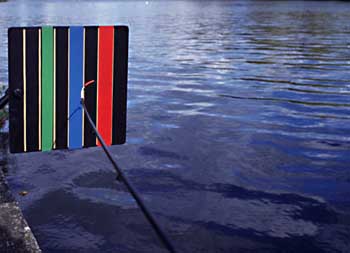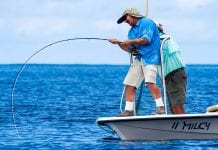Introduction – As we move into the autumn months, legering on rivers and lakes comes into its own. Here, Mark offers some valuable information for beginners who may be considering doing some legering for the very first time.
General
Legering is used to present a bait on the bottom. It does not use a float, but indicates bites on some kind of device attached to the line where it runs through, or from, the rod.
 |
| A quiver rod on a lake |
Legering is much easier than float fishing when the conditions are such that float fishing could be difficult, ie, strong winds; swim a long way out, or water very deep. Legering, however, is a very efficient method in its own right, and is chosen by many anglers simply because it is often the best method to catch fish.
It is, though, a boring method for the beginner, for he doesn’t usually take kindly to staring at a quivertip for hours on end. It isn’t half as interesting as watching a float, even for the experienced angler. Also, because it is a technique that fishes the bait hard on the bottom, it is not as efficient as the float at catching small fish.
When you try it, don’t make the mistake that many beginners do and think you have to fish a long way out simply because you are able to. It is a fallacy too, that big fish are always in the middle, or at least well away from the margins.
Stillwaters
There are two basic legering rigs, the running leger and the paternoster. Generally, the paternoster is best for stillwaters and the running lead better in rivers. I tend to use the paternoster for both stillwater and river, except for specialist applications which are not within the scope of this article. A typical legering session using a paternoster rig is as follows:
 |
| The fixed paternoster |
You have threaded the 4lb reel line through the rod rings and the rings on the swingtip. Now you tie in a 2ft length of 3lb line using a four turn water knot. Snip both lines with scissors so that you have a 6in length of 4lb line and an 18in length of 3lb line coming from the knot. Tie a blockend swimfeeder to the 4lb line and an 18’s spade end hook to the 3lb line.
Set your seat so that you are facing almost parallel to the bank, and place your rod rests so that the front one supports the rod about 3ft from the tip, with the butt resting on the back one at your side. Your hand should rest comfortably on the rod, ready to strike.
Hook on two maggots, fill the swimfeeder with maggots, and cast to the spot you have chosen. Allow the tackle to sink while the pick-up of the reel is still open, especially in deep water, otherwise the tackle will end up closer to you than you want. When the swimfeeder hits bottom, close the bale arm, tighten up to sink the line, and then slack off enough to hold the quivertip with a slight bend. When a fish pulls on the line the quivertip will pull round, whereas a fish that swims towards you will cause the quivertip to spring straight. Strike at either movement.
Every time you cast fill the ‘feeder, and cast fairly often even if you’re not getting many bites. Always cast to the same spot each time, for you don’t want bait spread over too wide an area.
Rivers
As with float fishing on rivers, legering on rivers is more difficult than legering on stillwaters, but river legering can be more rewarding, for the fish in rivers are more likely to respond to a legered bait than are stillwater fish. The rig for rivers is tied up exactly the same as for stillwaters, again using a quivertip. Also, the current of the river may dictate that you use a swimfeeder with a heavier lead in order to hold bottom.
 |
| Using a target board to aid bite detection |
If you are fishing where the current is quite strong the rod is best elevated in one rod rest so that as much line as possible is kept out of the water. That way, there is less pressure on the line from the current, which means you can get away with a lighter swimfeeder.
It is even more important on rivers to cast to the same spot each time, for the current carries the bait down the river making lines of feed that the fish follow to the source where your hookbait lies. The more lines of feed you create the less likely are the fish to follow the right one.
The force of the current will ensure there is some bend in the quivertip. Strike if the tip bends or straightens.
Mark Wintle












